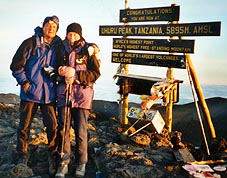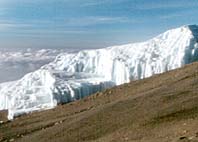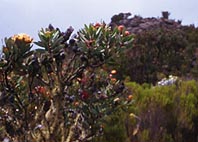




11/10/2002, 06:17

(Roof of Africa, 5895m)

Ewiges Eis (soll allerdings laut Studien bis in spätestens 50 Jahren weggeschmolzen sein).

4000 - 5000 m
Extereme Tag-Nacht Temperaturunterschiede bilden eine Halbwüste mit nur noch vereinzelten Pflanzen.
Lavasand und Felsen wechseln ab.

3000 - 4000 m
Meterhohe Pflanzen, weite Blumenwiesen, Felder und Steppen, Senezien und Lobelien, ein Traumland

Urwälder, erstrecken sich von 1800 - 3000 m. Dichter Regenwaldgürtel mit verscheidenen Tierarten.

ehemaliges Waldgebiet, jetzt fruchtbarer Boden, Acker und Weideland und Häuser.
Mount Kilimanjaro is the crown of Tanzania, also referred as the roof of Africa. The mountain rise abruptly from the open planes to form the snow capped peaks id Kibo and Mawnezi which are frequently fringed by clouds. The scenario makes rare and classic African images.
Occupying the 755 sq. kms. of Mount Kilimanjaro and it’s surroundings since 1973, is the Kilimanjaro National Park, which has been a game reserve from 1921.
The highest mountain in Africa is believed to have started formulating since 750,000 years ago and that there has been human habitation around the mountain for centuries. Archaeological discoveries have found rings and bowls made from obsidian flakes, which were found on the western slopes.
A German missionary, John Rebmann, was the first European to sight the snow-capped mountain in 1849. However it was geographer Hans Ludwig Meyer, who managed to reach the summit in 1889.
At 5,892 meters, it is the highest mountain in Africa and the highest walk able summit in the world. The diameter of its base is 72 kilometres. Kilimanjaro is a dormant, but not extinct volcano. Ominous rumbles can some times be heard and gases emerge from the fume holes in the crater.
Although just 3 degree’s south of the Equator, the peaks of both Kibo and Mawnezi have permanent caps of snow and ice.
Uhuru Peak is the highest point on Kibo and indeed the whole of Kilimanjaro. From Uhuru pea, with its spectacular hanging glaciers there are breathtaking views of the African plains some 20,000 feet below.
Gilman’s Point is the slightly lower peak of Kibo. There are the goals for the most trekkers. The peaks of Mawenzi are for mountaineers only.
Best time to visit: December through February are the warmest and clearest months and it is also dry, though colder from July to September. It is wet in the rainforest during the rains in April, June and November.
Access: The park gate is 90 kilometres from Kilimanjaro International Airport, about 1:30 hours drive. The closest major town is Moshi, 38 kilometres away. Marangu village is at the foot if the mountain closes to the gate.
The vast majority of climbers use Marangu route ns a round trip takes five days. Main highlights of this route are lush forests, the scenery and the wildflowers at Maundi crater and the views of Kibo and Mawenzi peaks.
Marangu gate is also the home of The Park Head Quarters. Other routes include Mweka Route, Machame Route and Shira Route.
(Tanzania Tourism_Trade_Directory 2002)